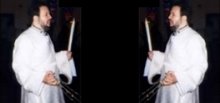St. Demetrius succeeded his noble father as the Roman proconsul (provincial governor) of Thessalonica, charged by the Emperor Maximian with defending the city from barbarian attacks, and exterminating the Christian population. Little did Maximian know that he had appointed a faithful Christian to this important position, one who would protect and nurture the Christians of the city rather than persecute them.
When he discovered his error, Maximian had Demetrius arrested, and imprisoned him in a bathhouse. At the same time, he put on “games” in which his champion, the barbarian wrestler Lyaeus, would fight with helpless Christians, throwing them out of the ring and to their deaths. From his prison cell, Demetrius blessed his servant Nestor to challenge Lyaeus, and shouting “O God of Demetrius, help me!,” Nestor slew the emperor’s champion.
In a furious rage, Maximian sent soldiers to kill Demetrius in the bathhouse, running him through with spears.
The Church of St. Demetrius is built over the site of the bathhouse, which you can visit in the crypt of the church. The saint’s relics are in the nave of the church, in a beautiful silver reliquary. They exude a sweet-smelling myrrh, for which St. Demetrius is called “The Myrrhstreaming” – and each year on his feast day, October 26, his relics are uncovered and cotton balls soaked in the myrrh and given out to pilgrims as a great blessing. I have one of these, and I can say that the scent is truly heavenly.
Holy Saints Demetrius and Nestor, pray to God for us!







